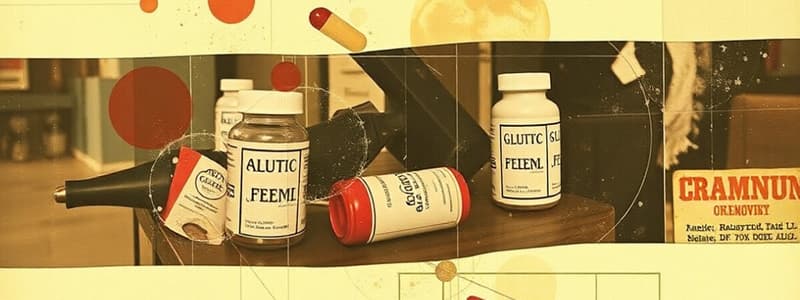Podcast
Questions and Answers
A patient is prescribed clopidogrel after a stent placement. Which instruction is most important to include in their discharge teaching?
A patient is prescribed clopidogrel after a stent placement. Which instruction is most important to include in their discharge teaching?
- Increase intake of green leafy vegetables.
- Inform the healthcare provider if you notice any signs of GI bleeding, such as black stools. (correct)
- Continue taking NSAIDs for pain relief as needed.
- Discontinue the medication 24 hours before any scheduled surgical procedures.
A patient experiencing an acute ischemic stroke arrives at the emergency department. What is the maximum time frame from the onset of symptoms during which alteplase (tPA) can be administered?
A patient experiencing an acute ischemic stroke arrives at the emergency department. What is the maximum time frame from the onset of symptoms during which alteplase (tPA) can be administered?
- Within 12 hours.
- Within 4.5 hours. (correct)
- Within 24 hours.
- Within 6 hours.
Which condition would be a contraindication for the administration of alteplase (tPA)?
Which condition would be a contraindication for the administration of alteplase (tPA)?
- Pulmonary Embolism
- Deep Vein Thrombosis
- Myocardial Infarction
- Hemorrhagic Stroke (correct)
A patient with chronic kidney disease is receiving epoetin alfa. The nurse should monitor for which adverse effect?
A patient with chronic kidney disease is receiving epoetin alfa. The nurse should monitor for which adverse effect?
A patient receiving filgrastim reports pain in the left upper quadrant (LUQ). Which action should the nurse take first?
A patient receiving filgrastim reports pain in the left upper quadrant (LUQ). Which action should the nurse take first?
A chemotherapy patient with thrombocytopenia is prescribed oprelvekin. Which assessment finding would be most concerning?
A chemotherapy patient with thrombocytopenia is prescribed oprelvekin. Which assessment finding would be most concerning?
A patient is scheduled for surgery in 6 days and is currently taking clopidogrel daily. Which action should the nurse anticipate?
A patient is scheduled for surgery in 6 days and is currently taking clopidogrel daily. Which action should the nurse anticipate?
A patient with chemo-induced anemia is prescribed epoetin alfa. Which laboratory value should the nurse monitor to assess the effectiveness and safety of this medication?
A patient with chemo-induced anemia is prescribed epoetin alfa. Which laboratory value should the nurse monitor to assess the effectiveness and safety of this medication?
A patient receiving filgrastim after chemotherapy reports experiencing bone pain. Which intervention would be most appropriate?
A patient receiving filgrastim after chemotherapy reports experiencing bone pain. Which intervention would be most appropriate?
Which medication requires monitoring of aPTT (activated partial thromboplastin time) to assess its therapeutic effect?
Which medication requires monitoring of aPTT (activated partial thromboplastin time) to assess its therapeutic effect?
A patient with iron-deficiency anemia is prescribed ferrous sulfate. Which instruction should the nurse include in the patient's teaching to enhance absorption?
A patient with iron-deficiency anemia is prescribed ferrous sulfate. Which instruction should the nurse include in the patient's teaching to enhance absorption?
A pregnant patient is prescribed folic acid. The nurse understands that folic acid is prescribed during pregnancy to prevent which condition in the fetus?
A pregnant patient is prescribed folic acid. The nurse understands that folic acid is prescribed during pregnancy to prevent which condition in the fetus?
A patient with pernicious anemia is receiving monthly vitamin B12 injections. What should the nurse emphasize in the patient's education regarding this treatment?
A patient with pernicious anemia is receiving monthly vitamin B12 injections. What should the nurse emphasize in the patient's education regarding this treatment?
A patient is started on heparin therapy for the treatment of a deep vein thrombosis (DVT). Which laboratory value is most important for the nurse to monitor?
A patient is started on heparin therapy for the treatment of a deep vein thrombosis (DVT). Which laboratory value is most important for the nurse to monitor?
A patient is receiving warfarin for chronic atrial fibrillation. The nurse reviews the patient's INR result and notes that it is 4.0. Which action should the nurse anticipate taking?
A patient is receiving warfarin for chronic atrial fibrillation. The nurse reviews the patient's INR result and notes that it is 4.0. Which action should the nurse anticipate taking?
A patient is prescribed dabigatran for long-term anticoagulation. What is an important instruction the nurse should include when teaching the patient about this medication?
A patient is prescribed dabigatran for long-term anticoagulation. What is an important instruction the nurse should include when teaching the patient about this medication?
A patient receiving heparin develops Heparin-Induced Thrombocytopenia (HIT). Which action is the most appropriate for the nurse to take?
A patient receiving heparin develops Heparin-Induced Thrombocytopenia (HIT). Which action is the most appropriate for the nurse to take?
A patient taking ferrous sulfate reports constipation. Which dietary recommendation is most appropriate for the nurse to provide?
A patient taking ferrous sulfate reports constipation. Which dietary recommendation is most appropriate for the nurse to provide?
A patient with a history of alcoholism is admitted with megaloblastic anemia. Which medication is most likely prescribed to address this type of anemia?
A patient with a history of alcoholism is admitted with megaloblastic anemia. Which medication is most likely prescribed to address this type of anemia?
What nursing intervention would be implemented when administering liquid iron preparations to a patient?
What nursing intervention would be implemented when administering liquid iron preparations to a patient?
Flashcards
Iron (Ferrous Sulfate)
Iron (Ferrous Sulfate)
Treats iron-deficiency anemia, causing fatigue, pale skin, and dizziness.
Folic Acid
Folic Acid
Used for megaloblastic anemia, pregnancy, and in alcoholics to correct folate deficiency.
Vitamin B12 (Cyanocobalamin)
Vitamin B12 (Cyanocobalamin)
Treats pernicious anemia by providing Vitamin B12, necessary for nerve function and RBC production.
Heparin
Heparin
Signup and view all the flashcards
Warfarin (Coumadin)
Warfarin (Coumadin)
Signup and view all the flashcards
Dabigatran
Dabigatran
Signup and view all the flashcards
Vitamin C
Vitamin C
Signup and view all the flashcards
Dairy Products
Dairy Products
Signup and view all the flashcards
Protamine Sulfate
Protamine Sulfate
Signup and view all the flashcards
Vitamin K
Vitamin K
Signup and view all the flashcards
Clopidogrel (Plavix)
Clopidogrel (Plavix)
Signup and view all the flashcards
Alteplase (tPA)
Alteplase (tPA)
Signup and view all the flashcards
Epoetin Alfa
Epoetin Alfa
Signup and view all the flashcards
Filgrastim
Filgrastim
Signup and view all the flashcards
Oprelvekin
Oprelvekin
Signup and view all the flashcards
Anticoagulants
Anticoagulants
Signup and view all the flashcards
Antiplatelets
Antiplatelets
Signup and view all the flashcards
Thrombolytics
Thrombolytics
Signup and view all the flashcards
Growth Factors
Growth Factors
Signup and view all the flashcards
Alteplase Time Window
Alteplase Time Window
Signup and view all the flashcards
Study Notes
- This document provides an overview of anemia medications, anticoagulants, thrombolytics, and hematopoietic growth factors
- It also includes uses, side effects, nursing care, and patient teaching points for each medication
Anemia Meds ("RBC Boosters")
- These medications are typically Iron, Folic Acid, and Vitamin B12
Iron (Ferrous Sulfate)
- Use: Treats iron-deficiency anemia, which causes fatigue, pale skin, and dizziness
- Side Effects:
- May cause teeth staining (liquid form), so use a straw when administering
- Causes black stools as a normal side effect
- Can be toxic to children, so store iron away properly
- Nursing Care:
- Take with Vitamin C (e.g., orange juice) to boost absorption
- Avoid dairy and antacids, as they block absorption
- Antidote: Deferoxamine (for iron overdose)
Folic Acid
- Use: Treats megaloblastic anemia (large RBCs), also important in pregnancy and for alcoholics
- Side Effects:
- Can cause neon yellow pee
- May hide B12 deficiency, so always check B12 levels first
- Foods: Found in citrus fruits, leafy greens, and meat
- Folic acid is fetus-friendly, helping to prevent birth defects
Vitamin B12 (Cyanocobalamin)
- Use: Treats pernicious anemia (no intrinsic factor, which means no B12 absorption)
- Side Effects:
- Risk of neuropathy (tingling, numbness) if untreated
- May lead to low potassium (hypokalemia), look out for muscle cramps
- Nursing Care:
- Schilling test can be performed to check stomach absorption
- Monthly B12 shots may be needed for life if a patient has pernicious anemia
- Foods: Eggs, dairy, and seafood
Anticoagulants ("Thin the Blood, Stop the Clots")
Heparin
- Use: Prevents DVT, PE, and stroke (fast-acting)
- Labs: Monitor aPTT (Normal: 30-40 seconds, Therapeutic: 60-80 seconds)
- Side Effects:
- Bleeding (black stools, bruising, hematuria)
- Low platelets (HIT - Heparin Induced Thrombocytopenia)
- Antidote: Protamine Sulfate
- Patient Teaching:
- Use soft toothbrush, electric razor to avoid cuts
- Avoid aspirin/NSAIDs due to risk of GI bleeds
Warfarin (Coumadin)
- Use: Long-term clot prevention for conditions like A-fib, DVT, and PE
- Labs: Monitor INR (Normal: 1, Therapeutic: 2-3)
- Side Effects:
- Bleeding (black stools, bruising, gums)
- Antidote: Vitamin K (leafy greens = okay in moderation)
- Patient Teaching:
- Wear a medic bracelet
- Avoid alcohol due to liver damage increasing bleeding risk
Dabigatran
- Use: A-fib, DVT, PE (no monitoring needed)
- Side Effects:
- Bleeding risk
- Antidote: Praxbind (idarucizumab)
- Patient Teaching:
- Swallow whole, don’t crush
- Avoid NSAIDs (bleeding risk)
Clopidogrel (Plavix)
- Use: Heart attack, stroke prevention, stents
- Side Effects:
- GI bleeding (black stools, bruising)
- Patient Teaching:
- Stop 5-7 days before surgery
- Avoid NSAIDs & aspirin
Thrombolytics ("Clot Busters (ER Drugs!)")
Alteplase (tPA)
- Use: MI, stroke (ischemic only!), massive PE, DVT
- Must Give FAST:
- MI: Within 2 hours
- Stroke: Within 3-4.5 hours
- Never Give If:
- Brain bleed (hemorrhagic stroke)
- Recent surgery due to risk of major bleeding
- Antidote: Aminocaproic acid (prevents bleeding)
- Nursing Tip:Use 2 IV lines and limit pokes to minimize bleeding risk
Hematopoietic Growth Factors ("Boost Blood Cell Production")
Epoetin Alfa
- Use: CKD, chemo-induced anemia, pre-op blood donation
- Side Effects:
- Thick blood which causes hypertension, stroke, and MI risk
- Monitor: Hgb < 12 g/dL (stop if higher)
- Patient Teaching:
- Iron supplements are needed for RBC production
- Monitor BP closely
Filgrastim
- Use: Chemo, neutropenia, bone marrow transplants
- Side Effects:
- Bone pain (from rapid WBC growth)
- High WBC count (leukocytosis > 10,000)
- Monitor: CBC w/ diff (stop if WBC > 10k)
- Patient Teaching:
- Report LUQ pain (spleen rupture risk)
Oprelvekin
- Use: Thrombocytopenia (chemo patients)
- Side Effects:
- Fluid retention leading to CHF risk, tachycardia, and A-fib
- Monitor: Baseline CBC & platelets
- Patient Teaching:
- Watch for swelling & irregular HR
Key Exam Takeaways
- Anticoagulants prevent clots (Heparin, Warfarin, Dabigatran)
- Antiplatelets stop platelets from sticking (Clopidogrel, Aspirin)
- Thrombolytics break existing clots (Alteplase)
- Growth Factors boost blood cells (Epoetin, Filgrastim, Oprelvekin)
Studying That Suits You
Use AI to generate personalized quizzes and flashcards to suit your learning preferences.



